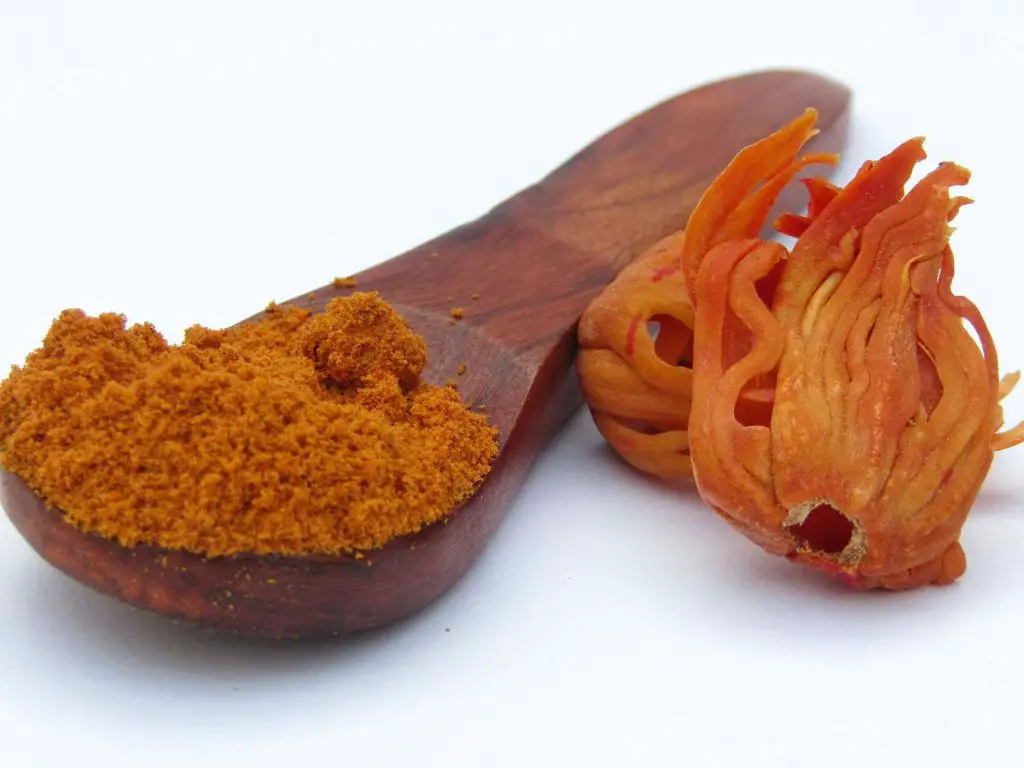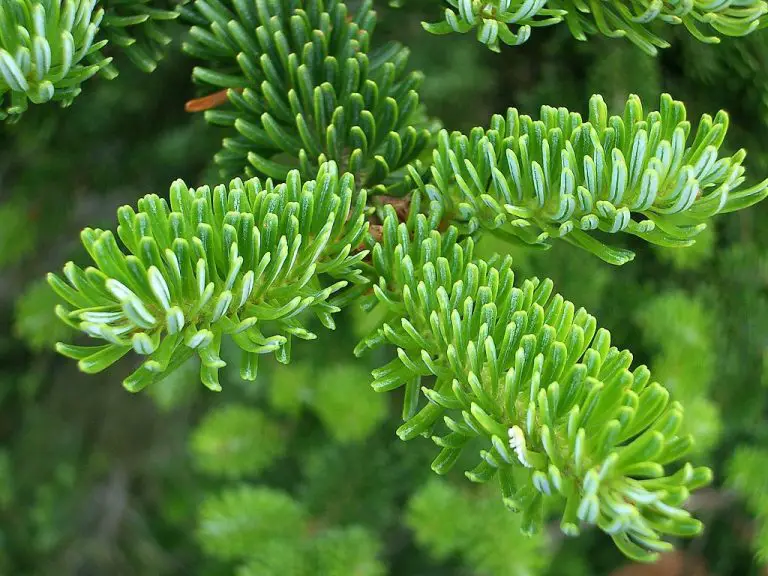What Is The Fragrant Spice Obtained From Nutmeg Shells?
Introducing Mace
Mace is a fragrant spice derived from the arillus, the lacy covering surrounding the nutmeg seed of the Myristica fragrans evergreen tree. The word “mace” comes from the Latin macir, meaning “fragrance.”[1] Mace has been prized as a spice for thousands of years and is native to the Moluccas, or Spice Islands, of Indonesia. It has a long history of use in Asian cuisines such as Indian, Pakistani, Indonesian, and Nepalese cookery.[2]
The ancient Romans used mace during the reign of Nero (A.D. 54-68). In the Middle Ages, it was an item of luxury and was brought to Europe by Arab spice merchants. By the 16th century, mace gained popularity along with nutmeg as an important commercial spice in the Western world.
Appearance and Flavor
Mace is the dried, bright red covering around the nutmeg seed kernel. When dried, mace turns into a brittle, yellow-orange thread-like spice that is often described as having a flavor similar to nutmeg but more delicate and sweeter. According to sources, mace has an aromatic, warm flavor that can be described as a combination of cinnamon, black pepper, citrus, and pine [1].

The flavor of mace is more subtle and delicate than nutmeg, providing a lighter, brighter orange and lemony taste. Mace is often used sparingly in recipes because its flavor can be overpowering in large amounts. Just a small amount of mace will provide aromatic nutmeg undertones and a hint of exotic spice.
Culinary Uses
Mace has a warm, citrusy, and slightly nutmeg-like flavor that makes it a versatile spice for cooking. Some of the most popular culinary uses of mace include:
Mace is commonly used to flavor baked goods like cakes, cookies, breads, and pastries. Its sweet and aromatic notes complement ingredients like cinnamon, nutmeg, vanilla, and chocolate. A small amount of mace can be added to cake batters, cookie doughs, pie fillings, and more.
The spice is also used to season savory dishes, especially those containing cream or cheese. Mace goes well with chicken, veal, fish, root vegetables, green beans, spinach, mushrooms, and creamy sauces. It works nicely in creamy soups, mashed potatoes, pasta dishes, and risottos.
Mace pairs well with other warm spices like cinnamon, ginger, cardamom, cloves, and of course, nutmeg. It also complements citrusy flavors from lemon, orange, lime, and herbs like thyme, sage, and basil.
Some popular dishes featuring mace include moroccan tagines, Swedish meatballs, bechamel sauce, pumpkin pie, eggnog, and many Indian curry dishes. The French often use it when making sausages and patés.
Overall, a small pinch of mace can add a subtle warmth and complexity to both sweet and savory recipes. Its flavor is more delicate than nutmeg, making it ideal for seasoning without overpowering.
Health Benefits of Mace Spice
Mace contains an impressive array of vitamins, minerals and antioxidants that provide many potential health benefits.
Nutrients
Mace is packed with vitamin A, vitamin C, and vitamin K. It also contains B vitamins including folate, niacin, vitamin B6 and riboflavin. Additionally, mace provides minerals like calcium, copper, magnesium, phosphorus and potassium.
The combo of vitamins and minerals make mace beneficial for skin health, bone strength, enhanced immunity, improved energy levels and more.
Medicinal Properties
Mace has long been used in folk medicine thanks to its medicinal properties. It has strong antioxidant and anti-inflammatory effects that may benefit health.
Research shows that two compounds found in mace called myristicin and elemicin have potent antioxidant properties that may protect cells from damage. Additionally, the anti-inflammatory effects of mace may aid arthritis, joint pain and stomach issues.
Some studies indicate that mace may also have antimicrobial properties and could help fight harmful bacteria and fungi for enhanced immunity and gut health.
Buying and Storing Mace
When buying mace, you can purchase it either whole or pre-ground. Whole mace retains its flavor and aroma longer than ground, but ground is more convenient. If buying whole, try to select pieces that are intact and unbroken. Make sure there is no sign of mold or dampness.
Properly stored, mace will maintain its flavor for about 3-4 years. Keep mace in an airtight container in a cool, dark, dry place away from heat and light. The pantry or a cupboard works well, but avoid storing near the oven which can cause faster deterioration. Whole mace will keep longer than ground. If buying ground mace in bulk for convenience, consider storing a portion in the freezer to help preserve its shelf life.
According to The Spruce Eats, whole mace can last 1-2 years stored properly, while ground mace will stay fresh for about 6 months to 1 year (source). Transferring some ground mace to the freezer can extend its shelf life for 2-3 years.
Mace vs Nutmeg
Mace and nutmeg come from the same plant, but there are some key differences between them (Mace vs. Nutmeg):
In terms of flavor, mace has a more delicate, lighter flavor compared to nutmeg. While nutmeg has an earthy warmth, mace is more bright and aromatic. The flavor of mace is often described as a combination of cinnamon and peppercorn.
When it comes to usage in cooking, mace is preferred in light-colored and delicately flavored dishes where its brighter flavor shines through. Nutmeg works well in heavier, warmer dishes that can stand up to its bold flavor. Mace enhances fruit, cheese and cream based dishes, while nutmeg goes well with meats, baked goods and root vegetables.
Mace is best used whole or ground, while nutmeg is more often used grated freshly. A little bit of mace goes a long way compared to nutmeg in terms of flavor impact. Mace blends well with other spices like cinnamon, cloves and ginger.
In summary, mace has a lighter, more delicate flavor that works well in lighter dishes, while nutmeg has a bold, earthy flavor that stands up to heartier foods (Quora). They both come from the nutmeg seed, but showcase subtly different flavor profiles and applications in cooking.
Mace Recipes
Mace has a sweet, warm flavor that pairs nicely in both savory and sweet dishes. Here are some delicious ways to use mace in recipes:
Appetizers
Add a pinch of mace to deviled eggs for a warm, aromatic flavor. Mace also complements seafood dips like crab or smoked salmon. Sprinkle some mace over roasted nuts or popcorn for a sweetly spiced snack.
Main Courses
Mace brings warmth to creamy soups like potato leek or butternut squash. It’s also excellent with chicken or fish, adding vibrance to dishes like Baked Chicken with Mushrooms and Herbs. A dash of mace lifts the flavor of roasted vegetables like carrots, parsnips and Brussels sprouts.
Baked Goods
A pinch of mace enhances the flavor of cookies, scones, breads and muffins. It’s especially nice with gingerbread, carrot cake, banana bread and pumpkin pie. Add a pinch to pancake or waffle batter for a subtly spiced breakfast treat.
Mace Essential Oil
Derived from the outer membrane of the nutmeg seed, mace essential oil is valued in aromatherapy for its powerful therapeutic effects. It has an intense, spicy aroma reminiscent of its nutmeg origins.
Some key aromatherapy uses of mace essential oil include:
- Relieving stress and anxiety – Mace oil has calming, sedative properties that can alleviate nervous tension when inhaled or used during massage. According to Gya Labs, its soothing aroma triggers feelings of relaxation.
- Boosting alertness – The stimulating scent of mace oil can counter fatigue and improve concentration.
- Enhancing libido – Mace oil is thought to act as an aphrodisiac.
- Easing cold symptoms – Mace oil can help clear nasal and respiratory congestion.
Mace oil should always be diluted with a carrier oil before applying to skin. Recommended dilution guidelines are 1-2% for adults and 0.5-1% for children. It’s best to consult an aromatherapy practitioner when using mace oil medicinally.
Fun Facts
Mace has a long history of medicinal use and was highly valued in medieval Europe. In the 14th century, a few pounds of nutmeg and mace were worth as much as a live sheep or ox [1].
The nutmeg tree takes 7-9 years to produce its first fruit and continues fruiting for 60+ years. The red, lacy mace covering is removed from the nutmeg seed and dried separately [2].
Mace was used as a natural food preservative before refrigeration was invented. Its antibacterial properties allow it to delay spoilage and mold growth [3].
In the 17th and 18th centuries, nutmeg was believed to ward off the plague. People carried nutmeg in their pockets or wore it as jewelry for protection.
Mace has a more delicate flavor than nutmeg. It is often used in lighter dishes like eggs, cream sauces, custards, and white sauces.
The nutmeg seed and mace covering always grow together, tightly intertwined until harvested and separated.
Mace contains antioxidants and has anti-inflammatory properties. Myristicin, a volatile compound in mace, may have positive effects on brain health.
FAQs
Mace has long played a unique role in cooking and natural medicine. Here are some common questions customers have about mace:
Q: What does mace taste like?
Mace has a warm, aromatic, sweet flavor that has hints of nutmeg. While it comes from the same fruit as nutmeg, mace has a more delicate flavor profile and less bitterness than nutmeg (Source).
Q: How do you use mace spice?
Mace can be used in both sweet and savory dishes. It’s commonly used in baked goods, curries, stews, chutneys, pickles, and beverages. Mace pairs well with milk, cream, cheese, eggs, carrots, peas, and spinach. Start with 1/8 to 1/4 teaspoon mace per pound of ingredients (Source).
Q: What are the health benefits of mace?
Mace contains antioxidants and has antimicrobial properties. Some research shows mace may help regulate blood sugar, improve brain function, enhance skin health, reduce inflammation, and act as a mild sedative (Source). However, more research is needed to confirm these benefits.
Q: Can you substitute nutmeg for mace?
Yes, nutmeg can be substituted for mace in equal amounts. However, the flavor won’t be exactly the same. Nutmeg is more pungent and spicy than delicate, aromatic mace. Adjust to taste based on the intensity you desire.





